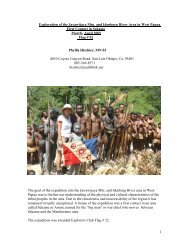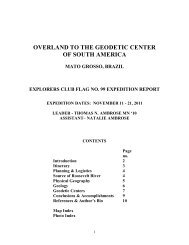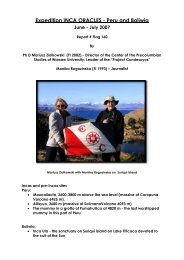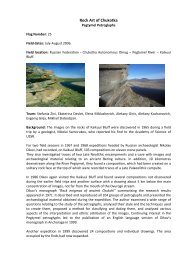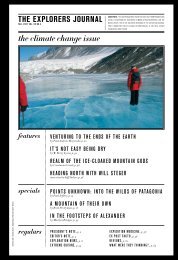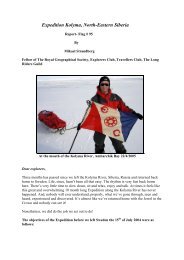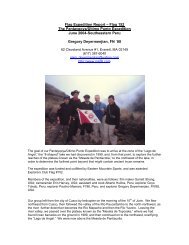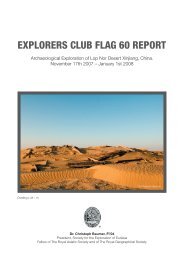the explorers journal - The Explorers Club
the explorers journal - The Explorers Club
the explorers journal - The Explorers Club
Create successful ePaper yourself
Turn your PDF publications into a flip-book with our unique Google optimized e-Paper software.
it’s all about having<br />
<strong>the</strong> right stuff<br />
As <strong>the</strong> Cold War with <strong>the</strong> Soviet Union intensified in<br />
<strong>the</strong> early 1960s, America found itself decidedly behind<br />
in <strong>the</strong> space race. Russia had already put a man (Yuri<br />
Gagarin) into orbit around <strong>the</strong> earth. And while America<br />
had sent two men suborbital (Alan Shepard and Gus<br />
Grissom), many of its rockets were exploding on <strong>the</strong><br />
launch pad. <strong>The</strong>n on Febrary 20, 1962, astronaut John<br />
Glenn came to bat for <strong>the</strong> U.S. and hit a home run, achieving<br />
three earth orbits in his Mercury-Atlas Friendship<br />
spacecraft. America pulled even with Soviets, never<br />
to fall behind again. Glenn retired from NASA shortly<br />
after, and served as senator from Ohio (Democrat)<br />
for three decades before returning to <strong>the</strong> heavens<br />
in 1998 aboard <strong>the</strong> Space Shuttle Discovery. At 77, he<br />
became <strong>the</strong> oldest man in space, a record that still<br />
stands. <strong>Explorers</strong> Journal Contributing Editor Jim<br />
Clash caught up with Glenn, now 88, to discuss his two<br />
flights and <strong>the</strong> current state of <strong>the</strong> U.S. space program.<br />
12<br />
JIM CLASH: Briefly set up <strong>the</strong> historical context<br />
for your pivotal Mercury flight in 1962.<br />
JOHN GLENN: What people forget is what prompted<br />
that flight, <strong>the</strong> rationale behind it. It was largely a<br />
part of <strong>the</strong> Cold War. <strong>The</strong> Soviets were claiming<br />
technical and research superiority to <strong>the</strong> United<br />
States. <strong>The</strong>y were bringing thousands of young<br />
people in from Third-World countries, giving <strong>the</strong>m<br />
an education in Moscow, <strong>the</strong>n sending <strong>the</strong>m to<br />
o<strong>the</strong>r places in <strong>the</strong> Soviet Union and back to<br />
<strong>the</strong>ir homes again, almost as little Communist<br />
emissaries.<br />
<strong>The</strong>ir claims of technical superiority were<br />
borne out by <strong>the</strong> fact that <strong>the</strong>y were launching<br />
things, while ours were too often blowing up on<br />
<strong>the</strong> pad. <strong>The</strong>y, of course, orbited before we did.<br />
We thought we were going to be first into space<br />
with Al Shepard on a suborbital flight in 1961,<br />
Astronaut John Glenn in a state of weightlessness, traveling at 17,500 miles per hour on February 20, 1962. image COurtesy NASA.



